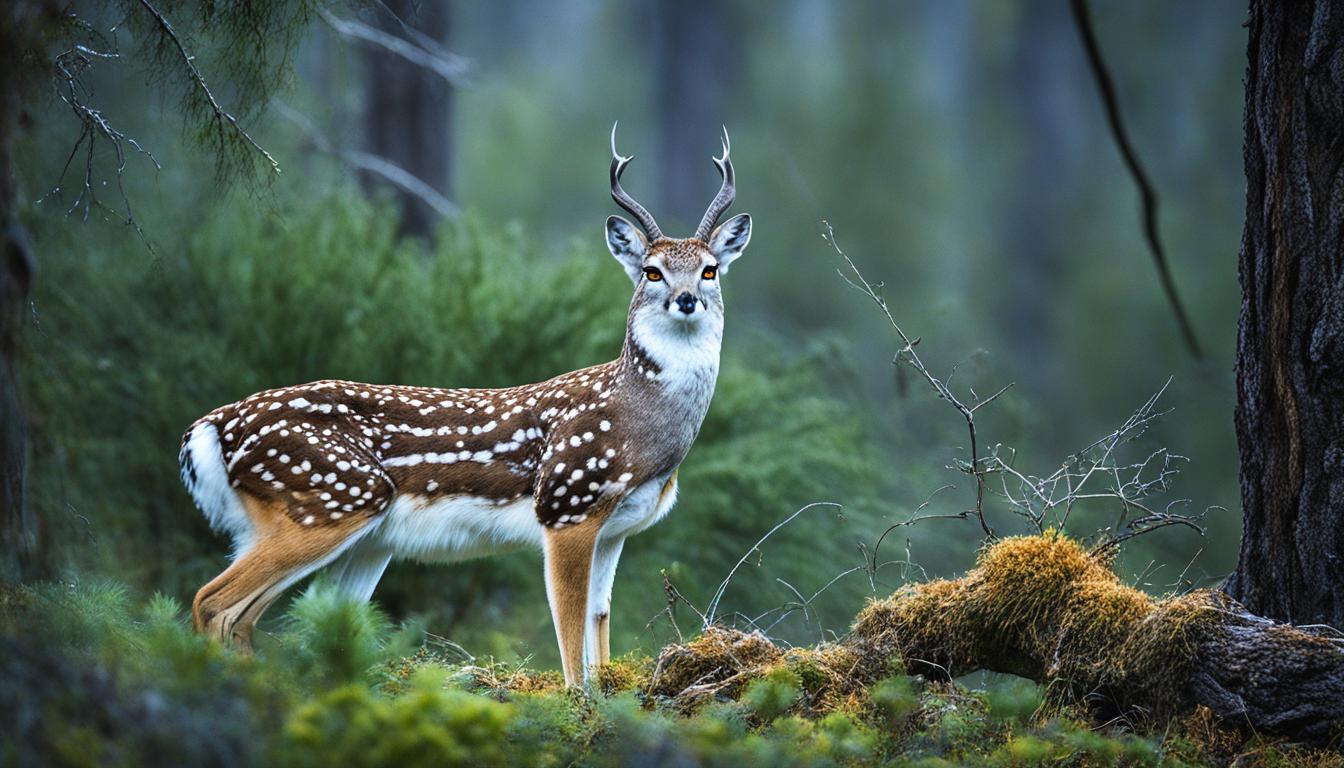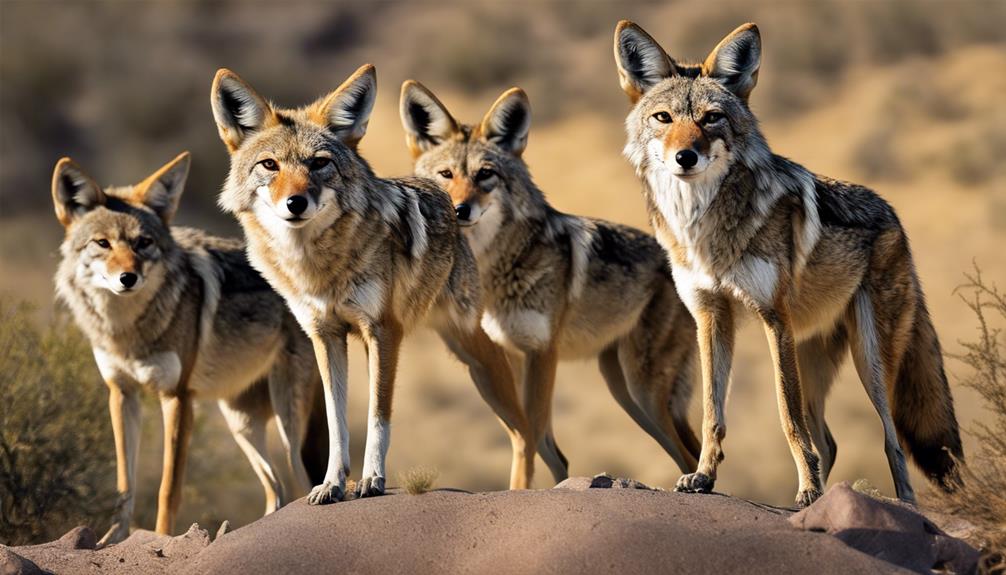Play's an essential part of dolphin societies, shaping their development and social lives. Through playful interactions, dolphins enhance their skills and strengthen bonds within their pods. They learn important behaviors, like foraging and communication, while fostering teamwork. Different types of play occur in various environments, each enriching their social dynamics. This playful behavior influences cultural transmission, as calves replicate and innovate new actions. If you want to uncover more about these fascinating dynamics, keep exploring the intriguing world of dolphin play.
Key Takeaways
- Play enhances vital locomotor skills, improving dolphins' foraging abilities and overall physical fitness within their social groups.
- Social learning through play fosters teamwork and strengthens social bonds among dolphins, essential for thriving in complex pod dynamics.
- Calves learn through imitation during play, aiding in the development of communication skills and social navigation within their communities.
- Experimentation during play encourages cognitive growth and problem-solving abilities, vital for adapting to environmental challenges and enhancing survival.
- Cultural transmission occurs as dolphins create and share novel play behaviors, marking important social and cultural indicators within their societies.
Types of Play in Dolphins

When you observe dolphins at play, you'll notice a fascinating variety of play types that showcase their intelligence and social nature. Dolphins engage in solitary play, like dropping and picking up objects repeatedly. In social play, they interact with each other through reciprocal chasing and playful fighting. Locomotor play features acrobatic displays, such as leaps and flips. You might also see dolphins with seaweed or human-made items, demonstrating their object play. Additionally, predatory play mimics hunting behaviors, allowing them to practice essential skills. These diverse play types not only highlight their playful spirit but also strengthen social bonds and foster cognitive development among dolphins, particularly in younger individuals. Notably, play behaviors in dolphins promote continued exhibition across species, reinforcing the importance of play.
Importance of Play in Dolphin Development

Play plays a significant role in dolphin development, as it allows young dolphins to practice essential skills for their future survival and reproduction. Through playful interactions, calves refine locomotor skills needed for foraging and mating. They also learn to make vocalizations important for adult communication. Engaging in play enhances their ability to synchronize movements with peers, shaping their social dynamics. Research has shown that play behavior aids in building social bonds and alliances among juvenile males.
| Skill Developed | Importance in Adulthood | Emotional Impact |
|---|---|---|
| Locomotor skills | Essential for foraging | Boosts confidence |
| Vocalizations | Key for communication | Strengthens social bonds |
| Herding techniques | Improves mating success | Fosters teamwork |
Ultimately, play is foundational in preparing dolphins for the challenges they'll face as adults.
Play and Social Learning
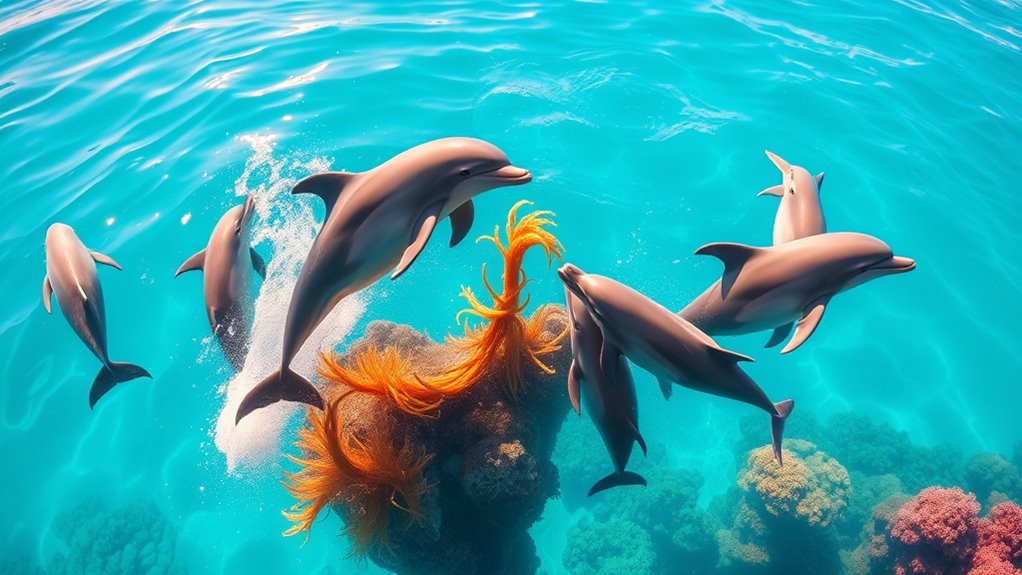
Through playful interactions, dolphins not only enjoy themselves but also engage in critical social learning.
When you observe dolphins at play, you'll notice that they learn behaviors by watching their peers. Calves often imitate other young dolphins, selecting playmates who are similar in age. This selective imitation helps them navigate their social networks and regulate emotions. Playful interactions also contribute to the development of stronger social bonds, as juvenile males engage in joint actions during play that resemble adult behaviors.
You can see observational learning in action when a dolphin shows interest in an object that another dolphin is playing with. Additionally, calves contribute to the creation and sharing of new play behaviors, enhancing the group's dynamics.
This playful exploration is essential for developing social skills and fostering cohesion within their pods, ultimately shaping their social structures and interactions.
Play in Different Environments

When you observe dolphins in the wild, their play takes on a dynamic, spontaneous quality that reflects their natural habitats. In contrast, captive environments can influence their playfulness, often leading to different behaviors and interactions. Understanding these variations helps you appreciate how environment shapes dolphin play and social structures. The ability of dolphins to use echolocation for navigation enhances their playful interactions as they can better explore their surroundings.
Wild Play Dynamics
While exploring the diverse environments they inhabit, dolphins exhibit a fascinating array of playful behaviors that reflect their adaptability and intelligence. In open waters, you might see them chase each other, manipulate seaweed, or create bubble rings. Coastal areas bring a different flavor of play, where dolphins engage in acrobatic displays and play-fighting, often using objects like seagrass blades. In riverine environments, despite strong currents, these dolphins still play, which helps them adapt to their challenging surroundings. This behavior is particularly evident in the daily activity patterns of dolphins, as they maintain active engagement with their environment. Across all these settings, dolphins interact with both natural and man-made objects, using play to develop problem-solving skills and strengthen social bonds. This playful exploration is essential for their communication and social cohesion, showcasing their unique dynamics in various habitats.
Captive Environment Playfulness
Captive dolphins exhibit a unique form of playfulness that reflects their adaptability, even in controlled environments. In these settings, you'll notice dolphins engaging with various objects, from balls to seaweed, enhancing their cognitive development. Play often involves social interactions, showcasing their cooperative nature and communication skills. This playful behavior is essential for their overall development, as it mirrors the role of scientific methods in understanding and classifying animal behaviors.
| Aspect | Description | Example |
|---|---|---|
| Object Types | Variety of items for play | Balls, ropes, seaweed |
| Social Dynamics | Cooperative and competitive play | Passing objects |
| Age Influence | Young dolphins play more frequently | Calves vs. adults |
| Play Complexity | Older dolphins engage in intricate play | Object manipulation |
| Cognitive Skills | Enhances social and hunting skills | Learning through play |
Communication During Play

When dolphins play, their communication goes beyond sounds; they use visual cues and facial expressions to signal their intentions. You'll notice how an open-mouth display can indicate playfulness, highlighting the importance of facial expressions in these interactions. Understanding these cues helps you appreciate the social dynamics and attentional states among dolphins during their playful moments. This is particularly evident as dolphins frequently use the open mouth expression during their social play interactions with each other.
Visual Cues Overview
In dolphin societies, visual cues play an essential role during play, enhancing communication and cooperation among individuals. While dolphins mainly rely on vocal signals, visual cues become significant when they're in close proximity. You'll notice that during play, dolphins display specific body language, such as mimicking open-mouth expressions, to engage with one another. This attentiveness to visual cues fosters social awareness and helps maintain harmony, reducing misunderstandings. Interestingly, dolphins exhibit an open-mouthed expression during play, which may prevent games from escalating into fights. Although water conditions can limit visibility, the use of visual cues suggests an evolutionary adaptation for complex interactions. In social play, these cues are important, but they're less prominent during solitary activities, highlighting their social function in dolphin behavior.
Facial Expressions Significance
Visual cues, like body language, are just part of the communication puzzle in dolphin societies.
One key expression is the open mouth, which resembles a smile during play and signals friendliness. You'll notice dolphins using this expression primarily when interacting with each other, not with humans or when playing alone.
When one dolphin displays its open mouth, the other often mirrors the expression within seconds, enhancing social bonding. This facial mimicry occurs around 33% of the time during play. This behavior is particularly notable as open mouth displays are not linked to aggressive actions.
With over 1,200 recorded open mouth events, it's clear this expression is essential for social interaction. It's a universal sign of playfulness, reinforcing the importance of visual communication in their playful behaviors.
Attentional States Awareness
How do dolphins navigate their social interactions during play? They rely on their advanced cognitive abilities to understand each other's attentional states.
When you observe dolphins playing, you'll notice they use cues like head direction and eye contact to gauge what others focus on. This awareness enhances their playfulness, making objects more intriguing when friends are engaged with them. Dolphins often communicate their playful intent through open mouth expressions, which helps signal fun and avoid conflict during interactions. Dolphins communicate playful intent through specific behaviors, creating complex interactions that foster social bonds. They're also sensitive to human attention, adjusting their responses based on whether you're looking or engaged.
Cultural and Social Implications of Play
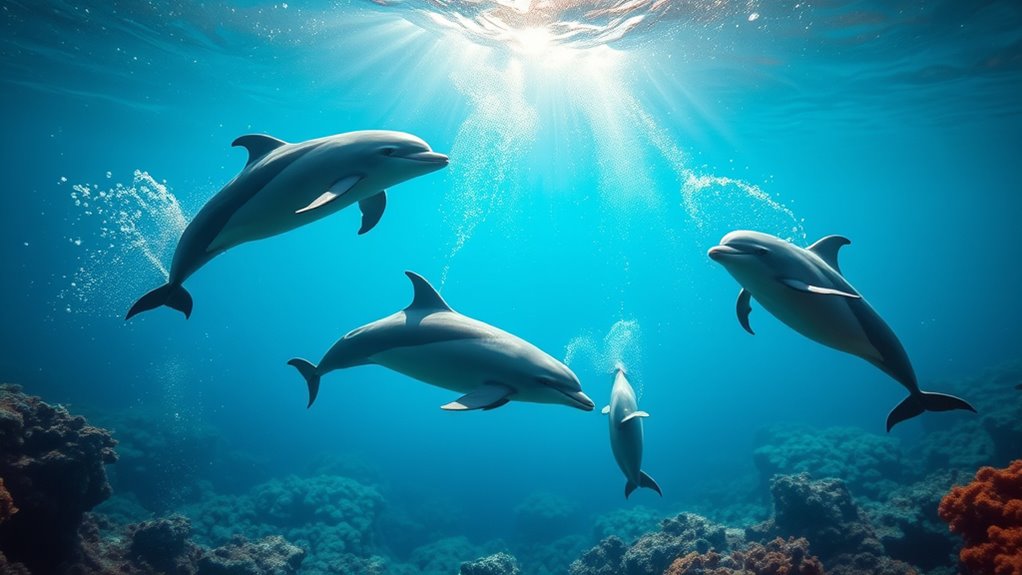
While many might think of play as mere fun, it plays an essential role in shaping the cultural and social fabric of dolphin societies. Through social learning, dolphins observe and imitate behaviors, facilitating cultural transmission. When calves engage in play, they create and spread novel behaviors, marking significant cultural indicators within their pods. Social play fosters strong bonds, initially forming between mothers and calves before shifting to peer partnerships. This interaction helps male dolphins practice social skills and alliances, enriching their emotional intelligence. Additionally, play influences social dynamics, allowing dolphins to navigate complex group structures. Ultimately, play doesn't just entertain; it's a crucial component of dolphin culture that enhances social cohesion and cognitive growth, as evidenced by unique shared behaviors observed among different dolphin populations.
Playful Innovation and Adaptation
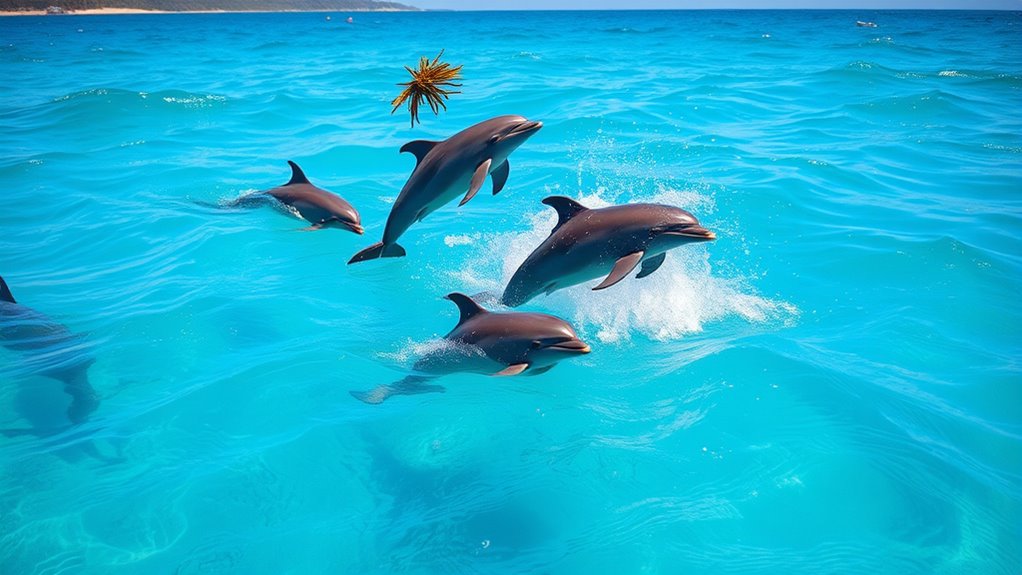
As dolphins engage in play, they not only entertain themselves but also spark innovation and adapt to their environments. Calves are the driving force behind this playful innovation, as they quickly learn and imitate novel behaviors. Their play becomes more complex with peers, enhancing cognitive skills and social bonds. Dolphins creatively use objects from their surroundings, showcasing their problem-solving abilities. This playful experimentation is vital for their development and adaptability. Additionally, the playful behavior exhibited by dolphins serves as a model for understanding communication through play in other species.
| Aspect | Description | Importance |
|---|---|---|
| Innovative Play | Calves lead in new play behaviors | Drives cultural transmission |
| Object Manipulation | Use of natural objects for play | Enhances cognitive development |
| Adaptive Behavior | Tailored play based on environment | Promotes survival skills |
| Social Learning | Expands networks through play | Strengthens community ties |
| Problem-Solving | Experimentation during play | Fosters flexible thinking |
The Evolutionary Significance of Play in Dolphin Societies

Play holds profound evolutionary significance in dolphin societies, shaping their development and social structures. Engaging in various forms of play, dolphins learn vital social and physical skills, enhancing their cognitive abilities. You'll notice that juvenile dolphins often practice behaviors like herding, mimicking adult interactions essential for future reproductive success. This playful exploration fosters strong social bonds, predicting future alliances. Males who play more as juveniles tend to achieve greater reproductive success in adulthood. Additionally, play allows dolphins to adapt to new challenges, increasing their survival chances. By creating a safe environment for experimentation, dolphins refine their problem-solving skills, leading to innovative behaviors that benefit their social groups. Furthermore, play behaviors observed in juvenile dolphins, such as mimicking adult consortships, are crucial for developing their future reproductive skills. Ultimately, play is integral to their evolutionary journey.
Frequently Asked Questions
How Do Different Dolphin Species Engage in Play?
Different dolphin species engage in play through various methods. You might observe them using objects like seaweed or shells for object play, while others participate in social play, like play-fighting.
In your view, locomotor play is exciting, as they jump and swim energetically. Some dolphins even mimic hunting behaviors in predatory play.
You'll see that play varies with age and sex, with juveniles often more active than adults.
What Are the Psychological Effects of Play on Dolphins?
Play notably impacts dolphins' psychological well-being. When you observe dolphins at play, you'll notice they experience joy and excitement, which enhances their emotional health.
Engaging in social play helps them learn to navigate their complex social networks and regulate their emotions. Additionally, play promotes cognitive growth by allowing them to practice problem-solving skills in a safe environment.
How Does Dolphin Play Compare to Play in Other Animals?
When you compare dolphin play to that of other animals, you'll notice some intriguing similarities and differences.
Dolphins, like humans, engage in playful behaviors well into adulthood, showcasing their intelligence. They leap, chase, and interact with objects, which strengthens social bonds.
While many animals exhibit play, dolphins' complex social structures and cultural transmission of behaviors set them apart, highlighting their unique adaptability and cognitive skills in playful interactions.
Can Play Reduce Stress in Dolphins?
Can play really be a lifeline in the turbulent sea of stress? While research doesn't directly link dolphin play to stress reduction, it's clear that engaging in play strengthens social bonds and fosters emotional regulation.
As you watch dolphins frolic, you'll see them learn and grow through interaction, which can enhance their overall well-being.
Play's physical activity and social learning aspects contribute to a more harmonious existence, helping them navigate life's challenges.
What Role Does Play Have in Dolphin Conservation Efforts?
Play plays an essential role in dolphin conservation efforts.
By studying their playful behaviors, you gain insights into their social and cognitive needs, which helps in crafting effective management strategies. Highlighting playful interactions can raise public awareness and support for conservation initiatives.
Furthermore, ensuring dolphins have opportunities to engage in play, both in the wild and captivity, enhances their welfare and strengthens their populations, ultimately aiding in their survival.
Conclusion
To sum up, play is the heartbeat of dolphin societies, driving their development and social bonds like a current shaping a river's course. Through playful interactions, dolphins not only learn essential skills but also enhance their communication and cultural practices. As they innovate and adapt in various environments, play becomes a powerful tool for survival and connection. Recognizing the significance of play offers us a deeper understanding of these intelligent creatures and the intricate societies they create.




